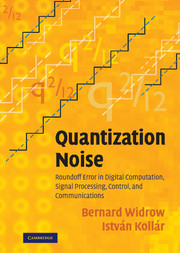 Quantization Noise
Quantization Noise Book contents
- Frontmatter
- Contents
- Preface
- Acknowledgments
- Glossary of Symbols
- Acronyms and Abbreviations
- Part I Background
- Part II Uniform Quantization
- Part III Floating–Point Quantization
- Part IV Quantization in Signal Processing, Feedback Control, and Computations
- Part V Applications of Quantization Noise Theory
- Part VI Quantization of System Parameters
- APPENDICES
- A Perfectly Bandlimited Characteristic Functions
- B General Expressions of the Moments of the Quantizer Output, and of the Errors of Sheppard's Corrections
- C Derivatives of the Sinc Function
- D Proofs of Quantizing Theorems III and IV
- E Limits of Applicability of the Theory — Caveat Reader
- F Some Properties of the Gaussian PDF and CF
- G Quantization of a Sinusoidal Input
- H Application of the Methods of Appendix G to Distributions other than Sinusoidal
- I A Few Properties of Selected Distributions
- J Digital Dither
- K Roundoff Noise in Scientific Computations
- L Simulating Arbitrary–Precision Fixed–Point and Floating–Point Roundoff in Matlab
- M The First Paper on Sampling–Related Quantization Theory
- Bibliography
- Index
J - Digital Dither
from APPENDICES
Published online by Cambridge University Press: 06 July 2010
- Frontmatter
- Contents
- Preface
- Acknowledgments
- Glossary of Symbols
- Acronyms and Abbreviations
- Part I Background
- Part II Uniform Quantization
- Part III Floating–Point Quantization
- Part IV Quantization in Signal Processing, Feedback Control, and Computations
- Part V Applications of Quantization Noise Theory
- Part VI Quantization of System Parameters
- APPENDICES
- A Perfectly Bandlimited Characteristic Functions
- B General Expressions of the Moments of the Quantizer Output, and of the Errors of Sheppard's Corrections
- C Derivatives of the Sinc Function
- D Proofs of Quantizing Theorems III and IV
- E Limits of Applicability of the Theory — Caveat Reader
- F Some Properties of the Gaussian PDF and CF
- G Quantization of a Sinusoidal Input
- H Application of the Methods of Appendix G to Distributions other than Sinusoidal
- I A Few Properties of Selected Distributions
- J Digital Dither
- K Roundoff Noise in Scientific Computations
- L Simulating Arbitrary–Precision Fixed–Point and Floating–Point Roundoff in Matlab
- M The First Paper on Sampling–Related Quantization Theory
- Bibliography
- Index
Summary
Quantization theory deals primarily with continuous–amplitude signals and continuous amplitude dither. However, within a digital signal processor or a digital computer, both the signal and the dither are represented with finite word length. Examples are digital FIR and IIR filtering, digital control, and numerical calculations. In these cases, intermediate results (e.g. products of numbers) whose amplitude is discrete, have excess bit length, so they must be re–quantized to be stored with the bit number of the memory. Before re–quantization, digital dither may be added to the signal, or sometimes this is even necessary to avoid limit cycles and hysteresis (see Fig. J.1, and Exercises 17.10—17.12, page 462).
Another scenario, when the dither is digital, is when the dither is generated within the computer for the quantization of analog signals. This usually means that each dither sample is produced by a pseudo–random number generator, and a D/A converter is used to convert the number to an analog level to be added to the input of the quantizer before quantization.
In both cases, it is good to know the properties of the most common digital dithers. Therefore, in this appendix we will investigate the properties of digital dither which is desired to be added to a digital signal before requantization.
QUANTIZATION OF REPRESENTABLE SAMPLES
An interesting approach was presented by Wannamaker, Lipshitz, Vanderkooy and Wright (2000). They have recognized that in general, no digital dither can completely remove quantization bias.
- Type
- Chapter
- Information
- Quantization NoiseRoundoff Error in Digital Computation, Signal Processing, Control, and Communications, pp. 685 - 696Publisher: Cambridge University PressPrint publication year: 2008
